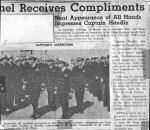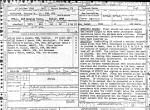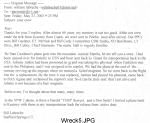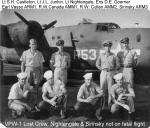1. FUNCTION OF THE UNIT.
Weather Reconnaissance Squadron ONE is the result of a call from our Pacific Fleet for a highly trained squadron with specially equipped aircraft to take over typhoon and other weather reconnaissance in the Central Pacific. Upon recommendation from Commander in Chief, U. S. Pacific Fleet, the squadron was formed with the following mission:
- Make routine or special weather reconnaissance flights as directed by the officer exercising operational control.
- Make in-flight weather observations and reports in accordance with current directives.
- Prepare and disseminate post flight summaries in accordance with current directives.
- Maintain aerological records in accordance with current directives.
By authority of the Chief of Naval Operations Weather Reconnaissance Squadron ONE was put in commission on 15 November 1945, Commander Dennis M. SZABO, U.S.N., commanding, under Fleet Air Wing FOURTEEN. The commissioning took place at N.A.A.S. Camp Kearney, Calif., where the squadron immediately commenced an intensive training program.
Since the squadron's primary purpose was to be weather flying, specific emphasis was placed on instrument training. Ground instruction covered construction and operation of the PB4Y-2 aircraft, navigation, and communications, and stressed weather flying. Training flights paid particular attention to Loran and Radar as invaluable navigation aids in heavy weather. Instrument flights, much of it under actual instrument conditions, including use of GCA, took up the greater part of the flight syllabus.
For its specialized work, the squadron had special equipment installed in its aircraft by the Assembly and
Repair Department of N.A.S., Corpus Christi, Texas. By the end of April, 1946, the fourteen aircraft
assigned the squadron were delivered, the 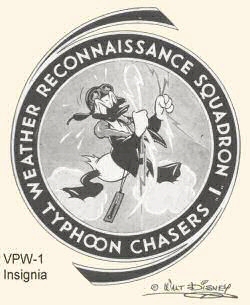 acceptance tests and ferrying being accomplished by squadron pilots and plane
crews. By the same time the training syllabus also had been completed, and the squadron awaited
orders from Commander Fleet Air, West coast to transport itself by air to its permanent base at N.A.B.,
Agana, Guam.
acceptance tests and ferrying being accomplished by squadron pilots and plane
crews. By the same time the training syllabus also had been completed, and the squadron awaited
orders from Commander Fleet Air, West coast to transport itself by air to its permanent base at N.A.B.,
Agana, Guam.
At this time the squadron was composed of fourteen PB4Y-2M type aircraft and fifteen flight crews. The squadron had, (and still has) no ground personnel. Each night crew consisted of four officers (Patrol Plane Commander, co-pilot, Navigator, and Aerologist), and four enlisted men (plane captain, second mechanic, first radioman, and second radioman-radar operator). Three aerological officers were lacking toward full complement.
During the last week of April and the first week of May, 1946, the squadron was engaged in a transpacific flight from its training base at N.A.A.S., Camp Kearney, Calif., to its present location. The Commanding Officer reported to Commander Fleet Air Wing EIGHTEEN for duty on May 4, 1946. Organizing and setting up the squadron consumed the next few days.
On May 12, 1946, the squadron flew its first typhoon reconnaissance flight. Several similar flights
took place on succeeding days, 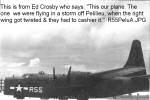 during which squadron planes sought and found some missing surface craft. For
these operations the squadron received a recommendation, see IV Appendices, from Commander Marianas. Routine
weather reconnaissance, air sea rescue, and other special flights as directed by Commander Marianas and CFAW
18 occupied the squadron during the remainder of May, 1946. The squadron participated in the
search for a lost Army transport plane. Several of the squadron aircraft succeeded in fixing the
location at pieces or wreckage believed to be from the missing plane.
during which squadron planes sought and found some missing surface craft. For
these operations the squadron received a recommendation, see IV Appendices, from Commander Marianas. Routine
weather reconnaissance, air sea rescue, and other special flights as directed by Commander Marianas and CFAW
18 occupied the squadron during the remainder of May, 1946. The squadron participated in the
search for a lost Army transport plane. Several of the squadron aircraft succeeded in fixing the
location at pieces or wreckage believed to be from the missing plane.
In the middle of May, the squadron sent three planes to Kwajalein and three to Peleliu on detached
duty. The Peleliu detachment was later reduced to two planes. The Kwajalein detachment, in addition
to its flights as directed by Fleet Weather central and Commander Fleet Air Wing EIGHTEEN, 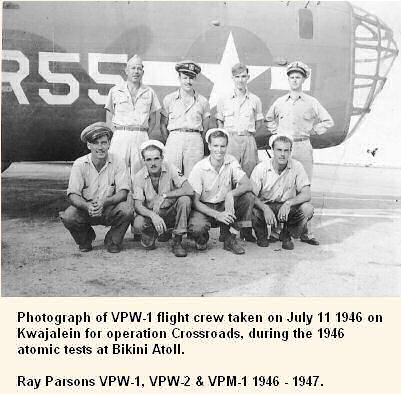 flew weather reconnaissance flights for the Crossroads operations. The Peleliu
detachment was made available for Air Sea Rescue work and weather and typhoon reconnaissance flights out of
range for the Guam detachment.
flew weather reconnaissance flights for the Crossroads operations. The Peleliu
detachment was made available for Air Sea Rescue work and weather and typhoon reconnaissance flights out of
range for the Guam detachment.
The squadron employs a special technique in typhoon reconnaissance. Each typhoon reconnaissance flight will completely circle the typhoon at minimum practicable radius. This is usually at a distance where surface wind velocity is about 60 knots, but will vary with the capabilities, experience, and confidence of individual flight crews. Every effort win be made to circle at approximately constant pressure. Flight altitude should be the maximum at which sufficient surface contact can be maintained to insure accurate surface wind observations.
If turbulence is not too severe fight shall be continued into the eye of the storm and its structure determined for post-flight report. Departure from the center will normally be at 6000 to 8000 feet, at which altitude the solid core of the storm will be from 20 to 80 miles thick with only light turbulence. After break-out on top of low clouds, the storm core should be circumnavigated again above the lower cloud deck in the clear, and a complete analysis of the storm structure obtained. Departure from the storm area is best made at altitude if surrounding build-ups are broken, but at low level if storm is well developed and surrounding build-ups form a solid wall. See Appendices for complete analysis of all typhoons flown by Weather Reconnaissance Squadron ONE.
At the beginning of June, 1946, the squadron was engaged in searching for The lost Army transport previously mentioned, besides sending out daily weather reconnaissance flights in accordance with instructions from Fleet weather Central. On 6 and 7 June Weather Reconnaissance Squadron TW0 was at N.A.B., Agana en-route to the squadron's permanent base at Sangley Point, Luzon, from which base its planes would operate under orders from Fleet Weather Central, Manila and Commander Fleet Air Wing EIGHTEEN. On 13 and 14 June ten officers and twelve enlisted ten left the squadron to report to Weather Reconnaissance Squadron TWO with three aircraft for duty. This left the Squadron with twelve crews and eleven aircraft, nine of which were to be serviceable at all times. Between 17 and 24 June the squadron flew its second typhoon. On 20 June 1946, a commendation for Lieutenant H. J. WITT, U.S.N.R. and his crew was read at quarters. This was for the excellent performance of duty on the part of Lieutenant WITT and his crew in the most recent typhoon.
BIOGRAPHY OF THE COMMANDING OFFICER
The Commanding Officer, Commander D. M. SZABO, AVH, USN. is a 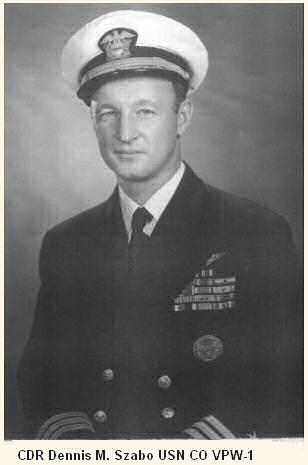 native of New Jersey. Prior to entering the Navy, he received his BA degree at
Rutgers and finished a year of Harvard law school. After finishing flight training at N.A.S.,
Pensacola, Fla., he joined a Catalina squadron in 1939. The squadron was based in Hawaii in 1940 and in the
Philippines at Sangley Point at the outbreak of the war. For The next few months Commander
SZABO's squadron was with the remnants of the American forces who were steadily pushed back through the East
Indies by the invading Jap forces. He ended up in Australia. His next tour of duty
was as Officer in Charge of a Coronado Service Unit. The year 1943 saw Commander SZABO's return
to the States as an instructor in Catalinas at N.A.S., Jacksonville. In 1944 he received orders
to N.A.S., Hutchinson, as Chief Flight Instructor in the new PB4Y syllabus. The close of the war
found Commander SZABO in training as a PPC of a Privateer crew and replacement squadron
commander. He next found himself in charge of a small nucleus of officers which was to become
the first weather reconnaissance squadron in the history of naval aviation. After assuming
command and commissioning the squadron, he led it through an intensive training program and brought it out
to its permanent base at N.A.B., Agana, Guam. Commander SZABO continued in command.
native of New Jersey. Prior to entering the Navy, he received his BA degree at
Rutgers and finished a year of Harvard law school. After finishing flight training at N.A.S.,
Pensacola, Fla., he joined a Catalina squadron in 1939. The squadron was based in Hawaii in 1940 and in the
Philippines at Sangley Point at the outbreak of the war. For The next few months Commander
SZABO's squadron was with the remnants of the American forces who were steadily pushed back through the East
Indies by the invading Jap forces. He ended up in Australia. His next tour of duty
was as Officer in Charge of a Coronado Service Unit. The year 1943 saw Commander SZABO's return
to the States as an instructor in Catalinas at N.A.S., Jacksonville. In 1944 he received orders
to N.A.S., Hutchinson, as Chief Flight Instructor in the new PB4Y syllabus. The close of the war
found Commander SZABO in training as a PPC of a Privateer crew and replacement squadron
commander. He next found himself in charge of a small nucleus of officers which was to become
the first weather reconnaissance squadron in the history of naval aviation. After assuming
command and commissioning the squadron, he led it through an intensive training program and brought it out
to its permanent base at N.A.B., Agana, Guam. Commander SZABO continued in command.
BIOGRAPHY OF EXECUTIVE OFFICER. (Appendix IV of Squadron History).
The squadron executive officer, Lieutenant Commander W. R. MEYER, AVH, USN, was born in Charleston, S.C. He was graduated from the U. S. Naval Academy in 1940, and spent two and one half years at sea on board the U.S.S. SAN FRANCISCO. He was on board at the start of the war and served in the Pacific until he was ordered back to flight training at the end of 1942. After winning his navy wings in 1943, Lieutenant Commander MEYER instructed in PVs at N.A.S, Beaufort, S. C. From 1944 to 1945 he learned about aerology at the PG School, U. S. Naval Academy. Upon completion of the course he received orders to Fleet Air Wing ONE at Okinawa as a typhoon specialist. This tour of duty took him to Shanghai, Keijo, Korea and Japan. In January, 1946, Lieutenant Commander Meyer received orders to Weather Reconnaissance Squadron ONE, which was then in training at N.A.A.S. Camp Kearney, Calif. He served as senior aerologist until in June, 1946, he became the squadron executive officer.
15 November 1945 - 30 June 1946
This report supplements previous history submitted for period from commissioning of squadron on 15 November 1945 to 30 June 1946.
Weather Reconnaissance Squadron One is based at NAS, Agana, Guam, M.I. under operational and administrative control of Commander Fleet Air EIGHTEEN. Operational control was passed from Commander Marianas to Commander Fleet Air Wing EIGHTEEN, 26 September 1946, by authority of Commander in Chief Pacific Fleet.
Two detachments, at Kwajalein and Peleliu, lower echelons over which the squadron exercised administrative control, were recalled on 12 August and 28 September 1946 respectively.
On 30 September 1946, by authority of Commander Marianas, two detachments, consisting of two planes each were sent to Samar, Philippine Islands, and Yonabaru, Okinawa. By authority of Commander in Chief Pacific Fleet, operational control of the Samar detachment passed to Commander Fleet Air Wing TEN, and operational control of the Yonabaru detachment was passed to Commander Fleet Air Wing ONE. These detachments are the only lower echelons over which this squadron has administrative control.
Number of typhoons tracked this quarter was (8). A typhoon developed in the Marshall Islands area, traveled westward, and passed thirty (30) miles north of Guam, on 21 September 1946. By order of Commander Fleet Air Wing EIGHTEEN, four planes were evacuated to Peleliu and four planes remained on Guam. Winds averaging from sixty (60) to seventy (70) knots, with gusts to ninety (90) knots were recorded during the passing of the storm, but no damage to planes or injuries to personnel were suffered. With the exception of the day the typhoon center passed Guam, this squadron tracked typhoon continuously, until distance from it to Guam prevented further reconnaissance. The availability of planes to continue tracking this typhoon was due to the extreme precautionary measures taken by this squadron in preparation for passing of the typhoon. Work of both men and officers was noteworthy and thus enabled the squadron to resume its normal functions immediately.
On 25 July 1946, Privateer, Bureau number 59961 returned from a typhoon reconnaissance flight with a large area of fabric missing from the topside of the port elevator, and some internal damage to the structure of the elevator. This was not the first incident of this type, but heretofore damage was slight and believed caused by incompliance with existing Bureau of Aeronautics orders, directing change in applying to all fabric. Many other or incidents of this nature occurred in later typhoon flights. Extensive test flights and experiments were conducted in an effort to remedy this condition. Results of these tests were not satisfactory and. data obtained from these flights has been forwarded to Bureau Aeronautics for further consideration.
| Month | Type | No. Flights | No. Hours |
| May | Weather Reconnaissance and Typhoon | 49 | 403.7 |
| Search | 18 | 158.1 | |
| Trans-Pac | 30 | 219.2 | |
| Training and special | 41 | 135.6 | |
| TOTAL | 138 | 917.1 | |
|
|
|||
| June | Weather Reconnaissance and Typhoon | 75 | 598.9 |
| Search | 17 | 171.0 | |
| Medical Evacuation | 1 | 6.4 | |
| Training and special | 36 | 137.9 | |
| TOTAL | 129 | 914.2 | |
The following pictures and other information below this point are not a part of the official history of VPW-1.
VPW-1 LOST PLANE INFORMATION (personal notation by Ray Parsons.)
The loss of a VPW-1 plane and crew in October 1946 was a jolt to me inasmuch as Earl Vasso had taken his time to show me around the San Diego area. I was two years into the Navy and wet behind the ears.
When the crash occurred we were informed of the crash by a note posted on the bulletin board. No information was given other that the site of the crash and the fact that all hands were believed to have been killed.
I tried to get on a search party and was told none were going there from Guam.
Several days later a letter was put into Earl's mailbox and remained there for several days until I finally pulled it out. It was from his girl friend in Ely, Nevada, Earl's hometown. They had an understanding that they would be married when he returned to the States. I sent her a letter explaining what had happened and gave her the information on the posted note and told her I would let her know of further developments.
Nothing further was told to us and one could get any information from VPW-1 HQ.
Compounding all this was when I found out during my record search for information on the Weather Squadrons, that the VPW-1/VPM-1 annual report (This combined report was because on 15 Nov 1946 VPW-1 was renamed VPM-1) mentioned nothing of the accident, although that report did say that VPM-1 lost one plane when it crashed on the runway at Sangley Point. That plane was piloted by Cdr Swenson. The only reference that could possibly be connected with the crash was in the Oct 1946 Historical Chronology, the date of the crash, which indicated "One weather reco flight. One search flight". Subsequent to that date, the Chronology shows on "search flight" on each of the following days: 22 Oct 1946, 26 Oct 1946, 31 Oct 1946 & 4 Nov 1946. No other search flights are mentioned during the remainder of the year.
- 1st picture from left: Commander of Air Wing 14 inspects the officers and men of VPB-197, VPW-1 and VPW-2.
March 16 1946
2nd picture from left: Enlisted men of VPW-1 line up for photo in front of one of their aircraft. March 16 1946.
3rd picture from left: Chief's of VPW-1 line up for photo. March 16 1946.
4th picture from left: The VPW-1 hanger while going through training at N.A.A.S. Camp Kearney, Calif.
Photo's courtesy of Ray Parsons VPW-1, VPW-2 & VPM-1 1946 - 1947
- 1st picture from left: Accident report of a VPW-1 aircraft which crashed into a mountain side while
beginning a typhoon recon mission near Manila, Philippines Islands on 19 Oct. 1946. This is something that was
mishandled by the navy. You will note that the loss of this plane is not mentioned in the squadron
history.
2nd picture from left: Bill Labreche tells how was bumped from the flight that crashed on 19 Oct. 1946 and saved his life.
3rd picture from left: VPW-1 crew lost in crash into a mountain during a typhoon recon mission.
Photo's courtesy of Ray Parsons VPW-1, VPW-2 & VPM-1 1946 - 1947.

